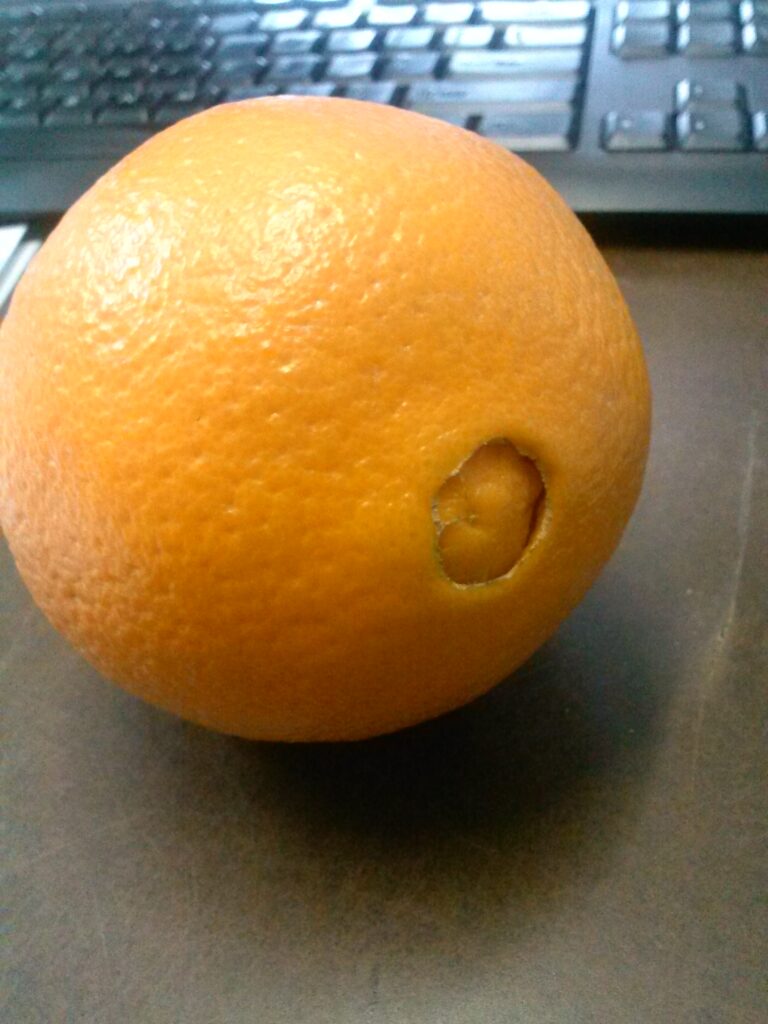Growing Navel Orange Trees
in Northeast Florida Landscapes
(Citrus sinensis ‘Navel’)
Origin of Navel Orange / Citrus sinensis ‘ Navel’ For Northeast Florida :

Navel oranges are thought to be a naturally occurring mutation of a Brazilian seleta orange and introduced into Florida near the mid 1800’s. The fruit has a characteristic ‘second’ fruit , it’s own little siamese twin, growing at it’s apex resembling a navel.
The navel orange market is dominated in California where cooler winter temperatures allow for sweeter tasting fruits. Northeast Florida citrus tree gardeners can take advantage of our cooler winter months by growing superior Navel oranges to our southern Florida neighbors! Navel orange fruit quality is excellent here in North Florida.
Winter Temperature Tolerance For Navel Oranges:
Navel oranges can be grown in zones 9-11.
Sun Exposure for the Navel Orange Tree in Northeast Florida:
Plant Navel orange trees where they will receive full sun in the Jacksonville and St. Augustine area landscapes.
Blooms and Fruit of Navel Orange Trees for Northeast Florida Landscape:
There may be nothing quite like a citrus tree in full bloom. The smell is magnificent! Mature citrus trees are said to be able to produce up to 100,000 blooms in a single year!
Navel orange trees are self pollinating, so there is no need for a second tree to pollinate your tree in order for it to produce fruit.
The mutation that caused the Navel orange to have its little ‘ second’ orange growing and protruding from the peel at its apex also left the fruit seedless!
Fruit is good quality in southern Florida and excellent fresh off the tree in Northeast Florida. Less acidic than most orange selections.
Peels (rinds) of the Navel orange are exceptionally sweet and make great culinary treats.
Thick skinned fruits are easy to peel and have a distinct navel orange flavor not found in other citrus selections. Navel oranges section easily and are great for just peeling and eating!
Soil Preference for the Navel Orange Tree:
It is no longer a recommended practice to amend the soil in the planting hole on Citrus trees in good soil according to the University of Florida’s Institute of Food and Agricultural Sciences. However, probably due to the simple fact that old habits die hard, one UFIFAS citrus publication cautions, if you are going to amend your soil be sure to use a 50-50 ratio. In other words, use equal parts soil amendment and native soil (that is the soil you dug out of the hole before placing the tree in it), and mix the amended soil together with the native soil before backfilling the hole around the tree.
Size of the Navel Orange Tree When Mature:
The mature size on a Navel orange tree is 20 ft tall and 15 ft wide.
Pruning and Growth Habits of Navel Orange Trees for the Northeast Florida Landscape:
– Remove suckers that sprout up from the trunk, or to remove dead wood that can cause problems when left on the tree.
– When purchasing trees form and S & J Nursery container less than a 30 gallon pot size, pruning may be needed to shape the young trees into a desirable framework, and lightly pruned each year to develop the lemon trees rounded or mushroom shaped canopy.
-As the tree matures it should be shaped by selecting 3 – 5 main branches, well spaced along the trunk for fruiting production. Remove branches with narrow angles, and sub branches that are crossing or rubbing on other branches.
Planting and Mulching Tips For Navel Orange Trees in the Jacksonville | St. Augustine area landscape:
NOTE: THIS IS IMPORTANT
-Be sure to plant into well draining soils, and keep the soil level of the dirt in the container above the soil level of the ground by 1-2 inches when you are finished planting. The soil that your tree was growing in should be slightly higher or level with the ground.
– Never bury the top of the root system ( the dirt in the pot that the tree was growing in). The soil in the top of the pot should be exposed to the air after planting, not buried by soil in any way.
Caution: Do not build berms around Citrus to hold water, as is recommended for pretty much all other trees. Leave a 12 inch diameter area around Citrus tree trunks with no mulch, do not put mulch up to the trunk of the tree on Citrus Root rot can develop quickly and good drainage is essential to a healthy tree.
Remove the grass and weeds growing under the foliage of any Citrus tree in Northeast Florida about a foot beyond where the foliage stops. Don’t allow grass and weeds to regrow under your Florida Citrus.
When planting in areas with a high water table, consider planting your Citrus into a raised berm a few feet high and 6or more ft wide. This will keep your Citrus roots up out of the water soaked ground during periods of heavy rain.
Wow, that was allot of don’ts! Here’s one last one. Don’t worry, it really isn’t as hard as it seems, once you get them going Citrus trees just keep on growing!
DO mulch under and around your citrus trees with Oak leaves, even if you have to beg some of of your neighbors. UFIFAS is recommending the practice to help deter the Asian Citrus Psyliid insect that is responsible for spreading Citrus Greening from tree to tree.
Keeping your Navel Orange Tree Free from Pests and Diseases:
When it comes to gardening, an ounce of prevention is worth a pound of cure. That is to say that, paying attention to proper planting, watering and fertilizing practices for your citrus tree is the best way to keep it healthy and growing well.
Water Requirements of the Navel Orange in the Jacksonville and St. Augustine area Landscape:
Newly planted citrus trees require watering every other day for the first month and twice a week for the first few months, or in sandy soils when the top two inches of soil is dry to the touch. Take care to make sure that newly planted citrus trees receive water at least once a week for the first 2 years after being planted, skipping watering altogether once the local rain season is here.
Mature citrus trees need little to no supplemental irrigation and are more often damaged by over watering than under watering.
When citrus trees need supplemental irrigation, make sure to irrigate the soil only and not the trunk or foliage, this is best done by hand with a hose.
Fertilizing Your Navel Orange Tree for Northeast Florida, Jacksonville and St. Augustine area Gardens:
Citrus trees tend to be a bit demanding on the fertilizing side of the equation.
A good quality fertilizer specifically formulated for citrus trees should be used. Fertilize in spring, again in summer and ,skip the fall application in Northeast Florida, and then again in January. Spread your fertilizer out into the circle of non grass area under the Canopy of your citrus tree.
Harvesting your Fresh Navel Orange Tree Fruits:
Navel orange trees will be ready for harvesting fresh from your tree from October to January.

